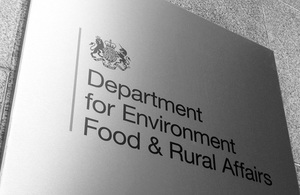England鈥檚 bathing water results 2015
Bathing water in the UK is improving.

A total of 97% of England鈥檚 bathing waters passed the minimum tougher standard this year.
In total, 63.6% of bathing waters meet the new Excellent standard.
Our nation鈥檚 bathing waters have continually improved since 1990 when just 27% met strict water quality standards. As our bathing water is better than ever EU standards are now also getting higher.
Environment Minister Rory Stewart:
Our bathing waters continue to get better, with 97% meeting new, tougher standards. We continue working to further improve the quality of our water, and last year our coast was the cleanest it has ever been.
Swimming is allowed and all beaches remain open; new EU standards are simply there to advise and inform the public on water quality.
I want Britain鈥檚 beaches, seas and lakes to have the cleanest water in the world. We need everyone to help us achieve this 鈥� from Government, water companies and councils to local communities.
Dr Pete Fox, Director of Land & Water at the Environment Agency said:
Water quality at beaches is better than any time in living memory, with dramatic improvements having been made over the last few decades. The Environment Agency has led successful work to monitor, investigate and reduce pollution, which has benefited the environment and people with nearly all of England鈥檚 beaches 97% meeting the new stringent water quality standards.
The Environment Agency will continue to encourage water companies, local authorities, farmers, and businesses to work together to maintain and improve water quality.
The results are based on samples taken by the Environment Agency over the last four years. Information about each beach is available on the Bathing Water Explorer website.
Over the last twenty years, we have made big steps to improve the quality of our water. This is thanks to the hard work of the Environment Agency, Defra, water companies, councils, local communities, farmers and environmental organisations. In addition, over 拢2.5 billion has been invested by water companies to improve bathing waters since privatisation.
The Environment Agency closely monitors the quality of our bathing waters and carries out regular testing and inspections. They also work closely with local partners and others to identify pollution sources and take action to protect and improve bathing water quality across the country.
Actions to improve bathing water include:
-
All of Blackpool鈥檚 four beaches have met the new tougher standards - with one achieving the highest standard of 鈥楨xcellent鈥�. United Utilities is investing 拢100 million to improve the water quality along the Blackpool coastline by 2020. Further action included fixing leaking pier toilets and work to stop donkey polluting beaches.
-
The bathing water quality at Hastings Pelham beach has improved dramatically from 鈥榩oor鈥� last year to 鈥榞ood鈥� in 2015. Southern Water has invested 拢3 million to investigate and fix uncapped manholes and identify misconnections in pipes. Extensive planting has taken place to cut pollution into Alexandra Park Stream by filtering bacteria and diverting pollution through ponds with floating islands.
-
The bathing water quality has dramatically improved at Teignmouth Town beach which has successfully met the new and tougher standards in 2015. Bird droppings have been identified as the main source of pollution at Teignmouth. To tackle this, anti-bird roosting measures have been installed on Teignmouth Pier to discourage birds using the area under the main pier buildings for roosting and nesting.
-
In Fleetwood and Morecambe South work with local caravan and chalet parks have ensured proper sewage treatment, while in Haverigg dog litter bins and controls on the beach will help to promote cleaner bathing water.
-
In Budleigh Salterton, Seaton and Porth, fencing off nearby steams and farming campaigns have helped to reduce pollution running into waters.